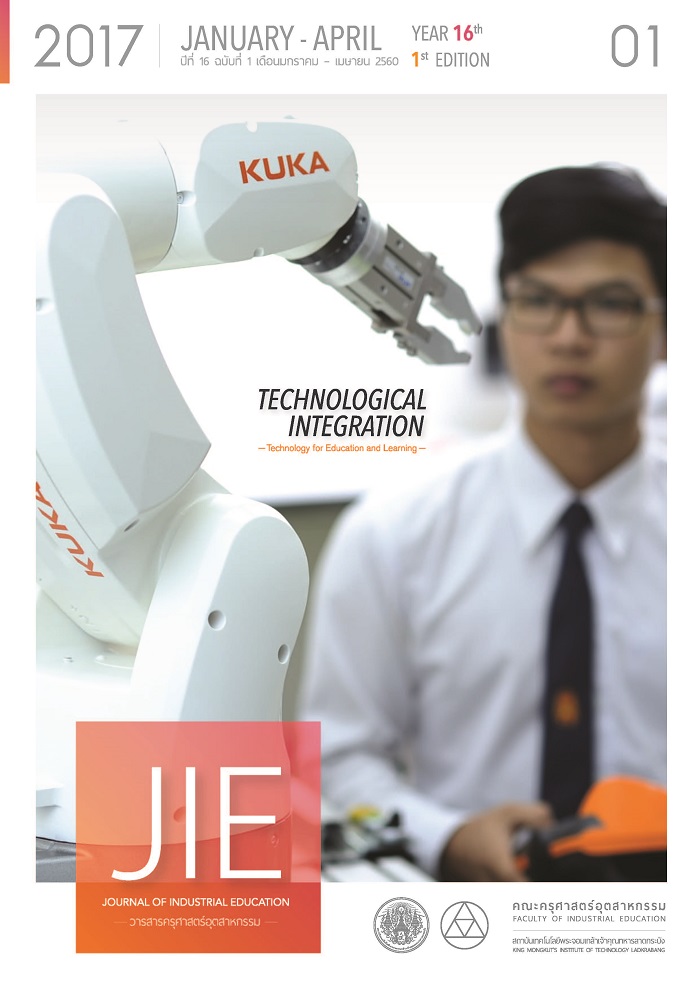THE DEVELOPMENT OF INDUCTIVE LEARNING ACTIVITIES PACKAGE WITH GROUP PROCESS ON CALCULUS 2 FOR UNDERGRADUATE STUDENT
Main Article Content
Abstract
The purpose of this research were: 1) to develop and effectiveness of Inductive Learning Activities With Group Processes On Calculus 2 for Undergraduate Student, 2) to study learning achievement after learning by Inductive Learning Activities With Group Processes On Calculus 2 for Undergraduate Student with criteria, 3) to study behavior’s group working by learning with Inductive Learning Activities With Group Processes, and The population consisted of 23 undergraduates who enrolled Calculus 2 in the second semester of the academic year 2015. The instruments in this research are: 1) Inductive Learning Activities With Group Processes On Calculus 2 for Undergraduate Student, 2) the quality assessment form for Inductive Learning Activities With Group Processes 3) Learning Achievement Test. The data were analyzed by frequency, percentage, mean, standard deviations and t-test. The results of this research were :1) The Inductive Learning Activities With Group Processes on the topic Derivative efficiency is 76.62/79.90, 2) The learning achievement after using Inductive Learning Activities with Group Processes pass the criteria , 3) behavior’s Group working is good level
Article Details
"The opinions and contents including the words in papers are responsibility by the authors."
"ข้อคิดเห็น เนื้อหา รวมทั้งการใช้ภาษาในบทความถือเป็นความรับผิดชอบของผู้เขียน"
References
[2] An Educational Reformation Committee. Office of Academic, Ministry of Education. 2001. The Research Synthesis of Students’Center. Bangkok : The teacher council of Thailand..
[3] Rotnukoonwanit, S. 2005. An Inductive Method Instruction Module by Group Process in Secondary School Students Grade 9: Possibility. Master of Education Thesis in Secondary Educaiton, Srinakharinwirot University.
[4] James B. S., 1998. The Effects of Diversity on Small Work Group Processes and Performance. Sage Journal, Retrieved June 20 2016.Available from: http :// hum.sagepub.com.
[5] Yoochomboon, B. 1986. The Behavior of Teaching and Studying Mathematics in Primary Schools. Bangkok: Odeon Store.
[6] MoonKham, S & MoonKham,O. 2005. Learning Management for Thinking Process Development. Bangkok: Parbpim. (in Thai)
[7] Dechakupt, P. 2001. Teaching as a Student’s Centre: Concept, Methods, and Teaching Techniques 1. Bangkok : The Mastergroup Management.
[8] Sawekvi, U. 2008. Ness’s Model on Integrated Teaching Method. A research, Department of Mathematics, Rajamangala University of Technology Thanyaburi.
[9] Phromwong, C. 2008. An Instructional Module. Retrieved from http://www.innowake.blogspot.com.
[10] Khuanharwet, B. 1999. Educational Innovation. 4th Ed. Bangkok: Charenwit Printing.
[11] Saiyot, L & Saiyot, A. 2001. Research Techniques for Education. 4th Ed. Bangkok: Suviriyasarn.
[12] Aunaromlert, T. 2006. Research Tools for Education: Innovation and Development. Nakorn Pathom: Faculty of Education, Silpakorn University.
[13] Wongyai, W. 1982. The New Dimension of Teaching Development. 3rd Ed. Bangkok: Thanet Printing.
[14] Suwannarong, S, Sukkamart, A & Pimdee, P. 2015. The Development of Instructional Package for Reinforce The system Thinking with Cooperative and Problem Based Learning for Mathayomsuksa 5 at Badindecha ( Sing Singhaseni) School. Journal of Industrial Education. Vol.(14)3. p.7784
[15] Srisa-ard, B. 1998. Teaching Development. 2nd Ed. Bangkok: Chomromdek.
[16] Pipitku, Y. 2003. Teaching and Studying Mathematics: Educational Reformation. Bangkok: Borpit Printing.
[17] Chuesuwantawee, C. 2001. Teaching Mathematics. Bangkok: Department of Curriculum and Instruction. Faculty of Education, Srinakharinwirot University.
[18] Muenthaisong, S. 2010. A Use of Cooperating Learning Techniques with Inductive Method towards Secondary School Students Grade 7’s Mathematics Learning Achievement and Attitude: Power. Master of Education Thesis in Curriculum and Instruction, Mahasarakham University.
[19] Duwao, W. 2011. A Learning Outcomes of Primary School Students grade 5 by Inductive Method in Mathematics subject: Multiplication and Division of the Fraction. Master of Education Thesis in Curriculum and Instruction, Chiangrai Rajabhat University.
[20] Wongwit, J. 2013. A Study of Learning Outcomes of Teaching Mathematics for Primary School Students Grade 6: Addition, Subtraction, Multiplication, and Division of the Fraction. Master of Education Thesis in Curriculum and Instruction, Chiangrai Rajabhat University.
[21] Nihad , M. 2005. Inductive Reasoning in The Algebra Classroom. Faculty of the Department of Mathematics. San Jose State University. [22] Office of the National Education. 1997. Educational Assurance System and National Educational Standard. Bangkok : The teacher council of Thailand.
[23] Chaimongkol, J. 2007. The Behavior Adjustment in the Mathematics Classroom by Groupwork, Secondary School Student Grade 1 at Mae Tuen Wittaya. Master of Education Thesis, Mahasarakham University.
[24] Soommart, C. 2008. A Study of the Use of Group Process for Teaching Science for Primary School Students Grade 3. Master of Education Thesis in Curriculum and Instruction, Nakorn Ratchasima Rajabhat University.

